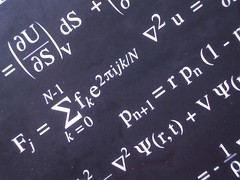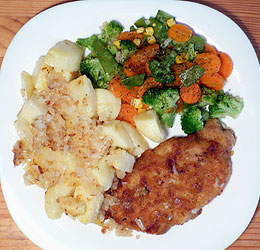 |
Prof Beate Heinemann, from the Atlas experiment at CERN had said that they may detect supersymmetric particles as early as this summer. But what if they don’t?
|
What if nature does not realise supersymmetry? Has my interest in supermathematics been a waste of time?
Superysmmetry
We hope that we’re just now at this threshold that we’re finding another world, like antimatter for instance. We found antimatter in the beginning of the last century. Maybe we’ll find now supersymmetric matter
Prof Beate Heinemann [1]
In nature there are two families of particles. The bosons, like the photon and the fermions, like the electron. Bosons are ‘friendly’ particles and they are quite happy to share the same quantum state. Fermions are the complete opposite, they are more like hermits and just won’t share the same quantum state. In the standard model of particle physics the force carriers are bosons and matter particles are fermions. The example here is the photon which is related to the electromagnetic force. On the other side we have the quarks that make up the neutron & proton and the electron, all these are fermions and together they form atoms.
Supersymmetry is an amazing non-classical symmetry that relates bosons and fermions. That is there are situations for which bosons and fermions can be treated equally. Again note the very different ‘lifestyle’ of these two families. If supersymmetry is realised in nature then every boson will have a fermionic partner and vice versa. In one swoop the known fundamental particles of nature are (at least) doubled! Moreover, the distinction between matter and forces becomes blurred!
A little mathematics
Without details, the theory of bosons requires the so called Canonical Commutation Relation or CCR. Basically it is given by
\([\hat{x},\hat{p}] = \hat{x} \hat{p} – \hat{p} \hat{x} = i \hbar \).
Here x ‘hat’ is interpreted as the position operator and p ‘hat’ the momentum. The right hand side of this equation is a physical constant called Planck’s constant (multiplied by the complex unit, but this is inessential). The above equation really is the basis of all quantum mechanics.
The classical limit is understood as setting the right hand side to zero. Doing so we ‘remove the hat’ and get
\(xp- px =0 \).
Thus, the classical theory of bosons does not require anything beyond (maybe complex) numbers. Importantly, the order of the multiplication does not matter here at all, just think of standard multiplication of real numbers.
The situation for fermions is a little more interesting. Here we have the so called Canonical Anticommutation Relations or CAR,
\(\{\hat{\psi}, \hat{\pi} \} = \hat{\psi} \hat{\pi} + \hat{\pi} \hat{\psi} = i \hbar\).
Again these operators have an interpretation as position and momentum, in a more generalised setting. Note the difference in the sign here, this is vital. Again we can take a classical limit resulting in
\(\psi \pi + \pi \psi =0\).
But hang on. This means that we cannot interpret this classical limit in terms of standard numbers. Well, unless we just set everything to zero. Really we have taken a quasi-classical limit and realise that the description of fermions in this limit require us to consider ‘numbers’ that anticommute; that is ab = -ba. Note this means that aa= -aa =0. Thus we have nilpotent ‘numbers’, that is non-zero ‘numbers’ that square to zero. This is odd indeed.
Supermathematics and supergeometry
In short, supermathematics is all about the algebra, calculus and geometry one can do when including these anticommuting ‘numbers’. The history of such things can be traced back to Grassmann in 1844, pre-dating the applications in physics. Grassmann’s interests were in linear algebra. These odd ‘numbers’ (really the generators of) are usually referred to as Grassmann variables and the algebra they form a Grassmann algebra.
One of my interests is in doing geometry with such odd variables, this is well established and a respectable area of research, if not very well represented. Loosely, think about simple coordinate geometry in high school, but now we include these odd numbers in our description. I will only reference the original paper here [2], noting that many other works evolved from this including some very readable books.
What if no supersymmetry in nature?
This would not mean the end of research into supermathematics and its applications in both physics & mathematics.
From a physics perspective supersymmetry is a powerful symmetry that can vastly simplify many calculations. There is an industry here that works on using supersymmertic results and applying them to the non-supersymmetric case. This I cannot see simply ending if supersymmetry is not realised in nature, it could be viewed as a powerful mathematical trick. In fact, similar tricks are already mainstream in physics in the context of quantising classical gauge theories, like the Yang-Mills theory that describes the strong force. These methods come under the title of BRST-BV (after the guys who first discovered it). Maybe I can say more about this another time.
From a mathematics point of view supergeometry pushes what we know as geometry. It gives us a workable stepping stone into the world of noncommutative geometry, which is a whole collections of works devoted to understanding general (usually associative) algebras as the algebra of functions on ‘generalised spaces’. The motivation here also comes from physics by applying quantum theory to space-time and gravity.
Supergeometry has also shed light on classical constructions. For example, the theory of differential forms can be cast neatly in the framework of supermanifolds. Related to this are Lie algebroids and their generalisations, all of which are neatly described in terms of supergeometry [3].
A very famous result here is Witten’s 1982 proof of the Morse inequalities using supersymmetric quantum mechanics [4]. This result started the interest in applying physics to questions in topology, which is now a very popular topic.
In conclusion
Supermathematics has proved to be a useful concept in mathematics with applications in physics beyond just ‘supersymmetry’. The geometry here pushes our classical understanding, provides insight and answers to questions that would not be so readily available in the purely classical setting. Supergeometry, although initially motivated by supersymmetry goes much further than just supersymmetric theories and this is independent of CERN showing us supersymmetry in nature or not.
References
[1] Jonathan Amos, Collider hopes for a ‘super’ restart, BBC NEWS.
[2] F. A. Berezin and D. A. Leites, Supermanifolds, Soviet Math. Dokl. 6 (1976), 1218-1222.
[3] A Yu Vaintrob, Lie algebroids and homological vector fields, 1997 Russ. Math. Surv. 52 428.
[4] Edward Witten, Supersymmetry and Morse theory, J. Differential Geom. Volume 17, Number 4 (1982), 661-692.












